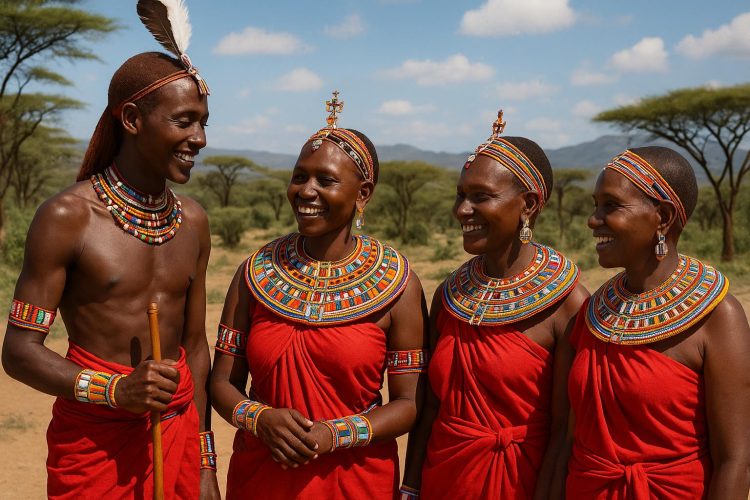The Samburu people in Kenya present an opportunity for visitors to engage deeply and meaningfully with a cultural landscape that is as vibrant as it is intricate. Closely related to the Maasai, the Samburu distinguish themselves through their unique nomadic lifestyle and traditional customs that have been passed down through generations. Visitors who delve into the depths of Samburu cultural experiences find themselves enriched with knowledge and appreciation for this fascinating community.
Samburu Cultural Experiences
The Samburu culture is a rich tapestry of practices and beliefs, offering an extraordinary insight into the lifestyle of these resilient people. Their culture is an amazing blend of traditions that speak volumes about their historical roots and their connection to the land.
Traditional Attire
Traditional Samburu attire is not simply clothing; it is a symbol of identity and an essential element of their cultural heritage. Samburu men are often seen in a shúkà, a vibrant cloth that is wrapped around the body. The choice of color and pattern of the shúkà is significant and is often used to display the ages and roles of the men within the tribe.
On the other hand, Samburu women dress in vibrant, multicolored materials that are both alluring and informative. Their attire is complemented by elaborate beadwork, which holds profound social significance. Beads are not mere ornaments but are indicative of social status, age, marital status, and even wealth. Each intricate design tells a story specific to the wearer and is often worn at ceremonial occasions to mark significant life events.
Ceremonial Practices
Ceremonies are cornerstones in Samburu society, marking pivotal life events and maintaining the social fabric of the community. Participation in or observation of these ceremonies offers profound insights into the hierarchical and spiritual dimensions of the Samburu.
Ritual Dances and Ceremonies
Ritual dances and ceremonies play an integral role in Samburu culture, serving as a medium of storytelling and communication. These dances are not merely performed for entertainment; they are an expression of spiritual beliefs and communal values. The dances, often accompanied by traditional songs, are occasions where the community gathers to celebrate, mourn, or mark a rite of passage. They are powerful expressions of the Samburu’s connection to their ancestors and the environment around them.
Initiation and Age Sets
A unique aspect of Samburu culture is the age-set system, a cyclical structure where individuals progress through stages of life with members of their age group. This system organizes society and delineates roles and responsibilities. Initiation ceremonies, such as those transitioning boys to warrior status, include rites like circumcision. These ceremonies are significant not only for the individual but also for the family and the community, underscoring the communal bonds that define Samburu life. Celebrations include vibrant feasts and dances, reflecting communal support and solidarity.
Dietary Practices and Local Cuisine
Exploring Samburu culture involves an exploration of their dietary practices, closely tied to their pastoral lifestyle. The Samburu people rely heavily on their livestock, which provide the primary components of their diet. Meat, milk, and occasionally blood are the main staples, reflecting a diet that is diverse but simple, tailored to their nomadic lifestyle.
Guests who engage deeply within Samburu society often have the privilege to partake in traditional meals. These meals are prepared using methods handed down through generations, revealing a tradition steeped in sustainability and resourcefulness. Engaging in these culinary traditions offers an authentic taste of Samburu life, enriched with the region’s flavors and stories.
Visiting a Samburu Homestead
An essential aspect of experiencing Samburu culture is visiting a traditional homestead, known as a manyatta. These homesteads are architectural testaments to the Samburu’s ingenious adaptation to their environment. Constructed with materials like mud, sticks, and dung, the manyatta is designed to be dismantled and reassembled as the community moves in search of grazing lands for their livestock.
Spending time in a manyatta provides visitors with firsthand experience of Samburu daily life. Visitors learn about food preparation, livestock management, and social interactions within the community. This experience affords a glimpse into the resilience and adaptability that characterizes the Samburu way of life.
Ethical Considerations
While the allure of the Samburu culture is compelling, visitors are urged to approach their experience with sensitivity and respect. The Samburu way of life should be engaged with ethically. This includes seeking permission before taking photographs, interacting respectfully with community members, and supporting local artisans by purchasing their crafts. By respecting these guidelines, visitors help to ensure a mutually beneficial experience that honors both the guest and host. For more insights on engaging in responsible tourism within Kenya, visit Explore Kenya.
Conclusion
A visit to the Samburu offers more than just a cultural education; it is an immersion into a world filled with tradition and resilience. From the distinctive attire that tells individual stories to the rhythmic dance of ceremonial practices, the Samburu people open a window into a lifestyle where community, tradition, and connection to the environment thrive harmoniously. Through embracing these experiences, visitors can forge a deeper connection with the Samburu people, gaining a unique appreciation for their dynamic cultural heritage.
